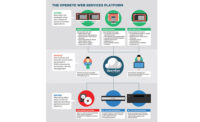One of the keys to video monitoring is the way in which it is presented to the operator. In the past this could be cumbersome and often led to many false alarms. But analytics and software platforms are making video monitoring simpler and easier to use.
“The biggest problem has been if you are taking 30 seconds to close a traditional non-verified alarm and now there is a video camera the operator has to connect to and pull up recorded video from — that could take them minutes,” explains Nik Gagvani of CheckVideo. “They had to become experts at every video system and have log-ins and passwords. It can be very cumbersome and we didn’t see much adoption. But two things have happened. One is automation software. It doesn’t take away reviewing time but maybe they are only doubling instead of quadrupling it. They still have to make a judgement call. On the analytics side we are guaranteeing we will deliver a 10-second clip with pre- or post-alarm video. In five seconds or less the operator will know what caused that alarm.”
Today some central stations and monitoring stations standardize on a specific software platform. A few common ones are Immix by Sureview, CheckVideo, Videofied (for verification), and I-View Now.
Others — particularly wholesale monitoring stations — still have to know multiple platforms. “We don’t standardize on anything,” says Daniel Forrest of Eyeforce Inc. “Because we are wholesale we do recommend a lot of things, but we try not to put anybody in a box and make dealers put in something that doesn’t work. But we do our own research and test the stuff and know what works best…. We have multiple platforms and the goal is every operator knows every platform. There is lengthy training to understand everything that is going on.”
Others don’t use software at all, instead relying on the operator to view the camera and, increasingly, analytics. “Analytics are getting better and better with time,” says Rick Charney of Stealth Video. “We are pretty independent with who we work with. We will continue to use best of breed and to find whichever products are best.”
Kastle’s solution to the issue is to standardize internally so that the operator only has one system to learn, explains Thomas Tardiff. “We use multiple platforms, but they all integrate to one alarm platform so that when a video alarm happens it comes to the exact same interface for the operator.”
Analytics have truly been a game changer, says Brad Gordon of Viewpoint Monitoring. “Around 10 years ago when we started, it was horrible unless you bought military grade. There were tons of false alarms. Now there are a handful of companies with analytics that really work as advertised. Another huge thing has been the advent of megapixel high-definition cameras that are not bandwidth hogs. Historically they used so much bandwidth they weren’t particularly useful for remote monitoring. But now companies are making phenomenal high-def megapixel cameras that use much less bandwith.”
Cloud and cloud storage is also making video monitoring easier, Gordon adds. “We use the cloud a lot. We have redundancies for everything we do, so we have onsite, offsite and now cloud storage. It is fantastic.”
Forrest agrees. “I think that there are so many things companies are trying to do with cloud video and analytics and it is all based on technology that is right there, he says. “The cost of entry is coming down and I think it will soon be common for everybody to have it.”






